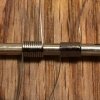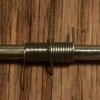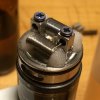Vacation from testing continues.
You are using an out of date browser. It may not display this or other websites correctly.
You should upgrade or use an alternative browser.
You should upgrade or use an alternative browser.
Wire/coil gauge efficiency testing
- Thread starter Boden
- Start date
- th_trl_thread_readers 0
- Status
- Not open for further replies.
I'm curious. What is your favorite build. Need Width and ID, wire gauge and watts o heat generated and atty.
Thanks
Thanks
Ohh about 36-30-36.
Well saidOhh about 36-30-36.
Going on vacation to do some south sea surfing.
Be back... When I get back.
Keep your mods out of the water!
This is from a private conversation I was having. Much more technical than I usually share on the open forum. Thought I'd share it with y'all before I head out on vacation.
-----------------
Heat seeks equilibrium. It (heat) wants to find equilibrium by flowing to cold areas of a closed system. It, like electrons, will take the path with the lowest resistance/thermal impedience mismatch.
In an atty it has three paths. First Into the posts, then into the juice and then into the air.
The wire mass heading to the posts is the current. The temperature differential between the coil and the posts is the pressure. The more mass the legs have the more heat can escape that route. Basically small wire is a bottleneck to this flow. This can be seen when you glow a coil. The legs and outside wrap are loosing a good bit of heat to the posts and will never glow like the middle of the coil.
This is lost heat.
Next you have heat flow to the juice. The heat wants to flow into the juice but the size of the wire and contact area of the wire and wick determines rate of flow. A 30ga wire has a width of 0.25mm, a 24ga wire has a width of .51mm. A 30ga wire has ~40% of its surface area in contact with the wick. A 24ga wire has ~20% of its surface area in contact with the wick. These are general imbedding figures.
Here is a example of two coils. One 24ga, one 30ga.
They are both 5.5mm wide and have the same ID
View attachment 598923
I cut off the legs at the sharpe mark.
View attachment 598925
And measured them
View attachment 598927
Then maths
View attachment 598921
As you can see the they both have very close to the same total surface area. The 24ga coil has twice the mass. So not only does the heat generated on the outside of the coil have twice as far to travel through the wire to the juice but the contact patch to the wick is half the size.
This is why thick wire heats more air than thin wire, even though both coils have basically (2.7% difference) the same total surface area. The outside of the coil simply gets hotter.
The practical effect of this is the 30ga coil will evaporate ~twice the amount of juice in a 4 second puff than the 24ga coil at the same wattage.
Basically, if you want to win a cloud competition build with small wire in a 2 or 3 wire parallel configuration (Depending on desired resistance)
View attachment 598931
I'm not very good at communicating these ideas as my mind moves much faster than I can type. I hope this makes sense.
Sincerely, Boden
-----------------
Heat seeks equilibrium. It (heat) wants to find equilibrium by flowing to cold areas of a closed system. It, like electrons, will take the path with the lowest resistance/thermal impedience mismatch.
In an atty it has three paths. First Into the posts, then into the juice and then into the air.
The wire mass heading to the posts is the current. The temperature differential between the coil and the posts is the pressure. The more mass the legs have the more heat can escape that route. Basically small wire is a bottleneck to this flow. This can be seen when you glow a coil. The legs and outside wrap are loosing a good bit of heat to the posts and will never glow like the middle of the coil.
This is lost heat.
Next you have heat flow to the juice. The heat wants to flow into the juice but the size of the wire and contact area of the wire and wick determines rate of flow. A 30ga wire has a width of 0.25mm, a 24ga wire has a width of .51mm. A 30ga wire has ~40% of its surface area in contact with the wick. A 24ga wire has ~20% of its surface area in contact with the wick. These are general imbedding figures.
Here is a example of two coils. One 24ga, one 30ga.
They are both 5.5mm wide and have the same ID
View attachment 598923
I cut off the legs at the sharpe mark.
View attachment 598925
And measured them
View attachment 598927
Then maths
View attachment 598921
As you can see the they both have very close to the same total surface area. The 24ga coil has twice the mass. So not only does the heat generated on the outside of the coil have twice as far to travel through the wire to the juice but the contact patch to the wick is half the size.
This is why thick wire heats more air than thin wire, even though both coils have basically (2.7% difference) the same total surface area. The outside of the coil simply gets hotter.
The practical effect of this is the 30ga coil will evaporate ~twice the amount of juice in a 4 second puff than the 24ga coil at the same wattage.
Basically, if you want to win a cloud competition build with small wire in a 2 or 3 wire parallel configuration (Depending on desired resistance)
View attachment 598931
I'm not very good at communicating these ideas as my mind moves much faster than I can type. I hope this makes sense.
Sincerely, Boden
Back from vacation. Sleep then science!
Welcome home!
Back from vacation. Sleep then science!
Good mornin' B. I'm intrigued by your guidance on variations of contact surface area respective to wire gauge. Before we go there for some specifics having some problems with the attachment links at your post #146. Could we maybe appeal to the powers that be for some help and a fix? Or are the permissions off at the source elsewhere?
Welcome back and hope the break did you good.
Good luck.
Good mornin' B. I'm intrigued by your guidance on variations of contact surface area respective to wire gauge. Before we go there for some specifics having some problems with the attachment links at your post #146. Could we maybe appeal to the powers that be for some help and a fix? Or are the permissions off at the source elsewhere?
Welcome back and hope the break did you good.
Good luck.
This is from a private conversation I was having. Much more technical than I usually share on the open forum. Thought I'd share it with y'all before I head out on vacation.
-----------------
Heat seeks equilibrium. It (heat) wants to find equilibrium by flowing to cold areas of a closed system. It, like electrons, will take the path with the lowest resistance/thermal impedience mismatch.
In an atty it has three paths. First Into the posts, then into the juice and then into the air.
The wire mass heading to the posts is the current. The temperature differential between the coil and the posts is the pressure. The more mass the legs have the more heat can escape that route. Basically small wire is a bottleneck to this flow. This can be seen when you glow a coil. The legs and outside wrap are loosing a good bit of heat to the posts and will never glow like the middle of the coil.
This is lost heat.
Next you have heat flow to the juice. The heat wants to flow into the juice but the size of the wire and contact area of the wire and wick determines rate of flow. A 30ga wire has a width of 0.25mm, a 24ga wire has a width of .51mm. A 30ga wire has ~40% of its surface area in contact with the wick. A 24ga wire has ~20% of its surface area in contact with the wick. These are general imbedding figures.
Here is a example of two coils. One 24ga, one 30ga.
They are both 5.5mm wide and have the same ID

I cut off the legs at the sharpe mark.

And measured them
Then maths

As you can see the they both have very close to the same total surface area. The 24ga coil has twice the mass. So not only does the heat generated on the outside of the coil have twice as far to travel through the wire to the juice but the contact patch to the wick is half the size.
This is why thick wire heats more air than thin wire, even though both coils have basically (2.7% difference) the same total surface area. The outside of the coil simply gets hotter.
The practical effect of this is the 30ga coil will evaporate ~twice the amount of juice in a 4 second puff than the 24ga coil at the same wattage.
Basically, if you want to win a cloud competition build with small wire in a 2 or 3 wire parallel configuration (Depending on desired resistance)

I'm not very good at communicating these ideas as my mind moves much faster than I can type. I hope this makes sense.
Thx @Boden. Kinda shuddered when I joined in here 3 yrs back at the 6 turns of this or that more or less wound any which way'll get ya this res. Some basic metric was awfully needed even if loosely based on principles anchored in reality. Something beyond that it's all about resistance, or amps, or whatever monolithic approach. The xTurns philosophy of this wrapper or that's never been too comforting or gotten me close to a temp target or output that I expected or wanted.
Think your above exhibit which better focuses attention on the wind geometry (what fits) over merely length or turns helps. I was very hopeful for Coil Toy a couple back if you recall but it never evolved in its accuracy or rendering.
You know I preach the gospel of balanced strain and contact but I'm by no means a purist. It sure is rewarding tho to be able to get in the ballpark predicting what the build will do.
I think we may both agree that optimizing surface wetted contact is the indicated tactic for achieving ideal wind performance. I'm curious how you arrived at the 20/40% (24/30g) ratio. All wick media vary in terms of deflection onto a wind's curved surfaces. Of the stiffest is woven ceramic and my rule of thumb is about 30%, a median est. which I think works well for this media for all gauges comparing the actual output. However, enhancing deflection doesn't always yield the expected result if there's a loss of compression against the wind, flow may be constrained, tight or loose. There is an optimal deflection I think for each type of media I've come to believe based on a great many side by side tests. Would have been interesting to do the math but I would have taken me 10 years to do what I've done the past three.
Also have an issue with the relevance of S-E's calc of surface area. It seems the total surface area of multiwire is computed based on the combined dia, rather than the multiple of the single wire SA. I'd like to pursue this discussion as I have a bit of time to look at the numbers.
What I try to tell beginners is to focus on the work of vaporization. That's contact. I favor something like a compact very flat alien over a clapton, certainly twisteds, which I mostly vaped for 2 years, for this reason. But my favs are t.m.c. twisted lead parallels when I can make the time to do them justice.



Thanks for the re-post. Interesting topic efficiency.

Good luck.
Think your above exhibit which better focuses attention on the wind geometry (what fits) over merely length or turns helps. I was very hopeful for Coil Toy a couple back if you recall but it never evolved in its accuracy or rendering.
You know I preach the gospel of balanced strain and contact but I'm by no means a purist. It sure is rewarding tho to be able to get in the ballpark predicting what the build will do.
I think we may both agree that optimizing surface wetted contact is the indicated tactic for achieving ideal wind performance. I'm curious how you arrived at the 20/40% (24/30g) ratio. All wick media vary in terms of deflection onto a wind's curved surfaces. Of the stiffest is woven ceramic and my rule of thumb is about 30%, a median est. which I think works well for this media for all gauges comparing the actual output. However, enhancing deflection doesn't always yield the expected result if there's a loss of compression against the wind, flow may be constrained, tight or loose. There is an optimal deflection I think for each type of media I've come to believe based on a great many side by side tests. Would have been interesting to do the math but I would have taken me 10 years to do what I've done the past three.
Also have an issue with the relevance of S-E's calc of surface area. It seems the total surface area of multiwire is computed based on the combined dia, rather than the multiple of the single wire SA. I'd like to pursue this discussion as I have a bit of time to look at the numbers.
What I try to tell beginners is to focus on the work of vaporization. That's contact. I favor something like a compact very flat alien over a clapton, certainly twisteds, which I mostly vaped for 2 years, for this reason. But my favs are t.m.c. twisted lead parallels when I can make the time to do them justice.



Thanks for the re-post. Interesting topic efficiency.
Good luck.
Last edited:
I haven't forgotten about this. Just busy at the moment.Thx @Boden. Kinda shuddered when I joined in here 3 yrs back at the 6 turns of this or that more or less wound any which way'll get ya this res. Some basic metric was awfully needed even if loosely based on principles anchored in reality. Something beyond that it's all about resistance, or amps, or whatever monolithic approach. The xTurns philosophy of this wrapper or that's never been too comforting or gotten me close to a temp target or output that I expected or wanted.
Think your above exhibit which better focuses attention on the wind geometry (what fits) over merely length or turns helps. I was very hopeful for Coil Toy a couple back if you recall but it never evolved in its accuracy or rendering.
You know I preach the gospel of balanced strain and contact but I'm by no means a purist. It sure is rewarding tho to be able to get in the ballpark predicting what the build will do.
I think we may both agree that optimizing surface wetted contact is the indicated tactic for achieving ideal wind performance. I'm curious how you arrived at the 20/40% (24/30g) ratio. All wick media vary in terms of deflection onto a wind's curved surfaces. Of the stiffest is woven ceramic and my rule of thumb is about 30%, a median est. which I think works well for this media for all gauges comparing the actual output. However, enhancing deflection doesn't always yield the expected result if there's a loss of compression against the wind, flow may be constrained, tight or loose. There is an optimal deflection I think for each type of media I've come to believe based on a great many side by side tests. Would have been interesting to do the math but I would have taken me 10 years to do what I've done the past three.
Also have an issue with the relevance of S-E's calc of surface area. It seems the total surface area of multiwire is computed based on the combined dia, rather than the multiple of the single wire SA. I'd like to pursue this discussion as I have a bit of time to look at the numbers.
What I try to tell beginners is to focus on the work of vaporization. That's contact. I favor something like a compact very flat alien over a clapton, certainly twisteds, which I mostly vaped for 2 years, for this reason. But my favs are t.m.c. twisted lead parallels when I can make the time to do them justice.



Thanks for the re-post. Interesting topic efficiency.
Good luck.
Good luck, feel better.  The vape'll keep.
The vape'll keep.
still stupid busy, and sick...
Bummer! Hope you get over it and less busy soon!

- Status
- Not open for further replies.
Similar threads
- Replies
- 58
- Views
- 4K
- Replies
- 11
- Views
- 3K
- Replies
- 11
- Views
- 71K
- Locked
- Replies
- 5
- Views
- 1K
- Replies
- 0
- Views
- 2K
Users who are viewing this thread
Total: 2 (members: 0, guests: 2)
